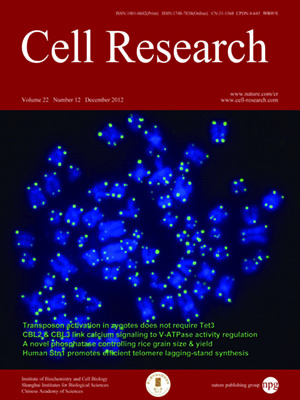
Advanced Search
Submit Manuscript
Advanced Search
Submit Manuscript
Volume 22, No 12, Dec 2012
ISSN: 1001-0602
EISSN: 1748-7838 2018
impact factor 17.848*
(Clarivate Analytics, 2019)
Volume 22 Issue 12, December 2012: 1666-1680
Peng Qi1,*, You-Shun Lin2,*, Xian-Jun Song1,*, Jin-Bo Shen2, Wei Huang1, Jun-Xiang Shan1, Mei-Zhen Zhu1, Liwen Jiang2, Ji-Ping Gao1 and Hong-Xuan Lin
2School of Life Sciences, Centre for Cell and Developmental Biology, Chinese University of Hong Kong, Shatin, New Territories, Hong Kong, China
Correspondence: Hong-Xuan Lin, Ji-Ping Gao,(hxlin@sibs.ac.cn; jpgao@sibs.ac.cn)
Increased crop yields are required to support rapid population growth worldwide. Grain weight is a key component of rice yield, but the underlying molecular mechanisms that control it remain elusive. Here, we report the cloning and characterization of a new quantitative trait locus (QTL) for the control of rice grain length, weight and yield. This locus, GL3.1, encodes a protein phosphatase kelch (PPKL) family — Ser/Thr phosphatase. GL3.1 is a member of the large grain WY3 variety, which is associated with weaker dephosphorylation activity than the small grain FAZ1 variety. GL3.1-WY3 influences protein phosphorylation in the spikelet to accelerate cell division, thereby resulting in longer grains and higher yields. Further studies have shown that GL3.1 directly dephosphorylates its substrate, Cyclin-T1;3, which has only been rarely studied in plants. The downregulation of Cyclin-T1;3 in rice resulted in a shorter grain, which indicates a novel function for Cyclin-T in cell cycle regulation. Our findings suggest a new mechanism for the regulation of grain size and yield that is driven through a novel phosphatase-mediated process that affects the phosphorylation of Cyclin-T1;3 during cell cycle progression, and thus provide new insight into the mechanisms underlying crop seed development. We bred a new variety containing the natural GL3.1 allele that demonstrated increased grain yield, which indicates that GL3.1 is a powerful tool for breeding high-yield crops.
Cell Research (2012) 22:1666-1680. doi:10.1038/cr.2012.151; published 13 November 2012